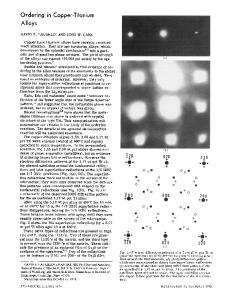Ordering and decomposition in semiconductor alloys
- PDF / 424,676 Bytes
- 4 Pages / 594 x 810 pts Page_size
- 52 Downloads / 411 Views
Ordering and decomposition in semiconductor alloys I
,
Jose Luis Martins” and Alex Zunger Solar Energy Research Institute. Golden, Colorado 80401 (Received 31 December 1985; accepted 16 M a y 1986) The stability of ordered semiconductor alloys has been studied, using total energy pseudopotential calculations. The ordered alloys are found to be stabilized with respect to disordered alloys via reduction of the internal strain and by chemical interactions. The Si-C and Si-Ge systems are used as illustrations, finding that ordered SixGel - should be a metastable alloy, in agreement with experimental observations.
Alloys of tetrahedrally bonded semiconductors, e.g., A, - B, C, have generally been grown in a disordered ( D ) phase.’ Their enthalpy of mixing,
- (1 - x ) H ( A C ) -xH(BC)
as calculated from the liquidus and solidus lines, was found to be positive in all cases.’ Such alloys are nevertheless stable at high temperatures due to the large entropy of mixing. Recently’ we have shown, based on a quantum mechanical calculation of ordered Ga, In, P, + alloys, that these semiconductor phases may be stable at low temperatures against disproportionation. Ordered phases of the Al,Ga, .As alloy3 and of the SixGe, - alloy4 have been observed. Concomitant with the empirical observation that all conventionally grown bulk semiconductor alloys are disordered, contemporary theories of structure and stability of semiconductor alloys’-7 have tacitly postulated that the enthalpy of mixing A H is always positive, neglecting all possibly attractive terms (e.g., charge transfers). For instance, in the delta lattice parameter (DLP) model of Stringfellow’ it is postulated that the enthalpy H of any phase, ordered or disordered, is a convex function of its lattice parameter, i.e., H = ( - K / a ) (where K is an empirical constant and p > 0). Hence, according to this model any phase with a lattice parameter obeying approximately Vegard’s law8 will necessarily have a positive enthalpy of mixing, proportional to the square of the lattice mismatch ha of the end-point compounds, or AH = 0 . 5 (~p + 1)x ( 1 -x ) K ( /ap-t 2 .For example, the large lattice mismatch between diamond and silicon ha = 1.86 A (or 41% of the average lattice constant) suggests in the DLP model that AH[S i c ] )O, yet S i c exists as a very stable “alloy.” Similarly, in Van Vechten’s model,6 positive optical bowing accompanying compound formation is interpreted as a (destabilizing) upward shift of the valence-band energies, leading to AH> 0 for disordered compounds if their band gaps are reduced relaJ. Mater. Res. 1 (4),JuVAug 1986 http://journals.cambridge.org
+
+
AH‘D’(Al-,B,C) =H(A,-,B,C)
tive to their average. The same argumentation can be extended to ordered alloys if we define optical bowing by analogy. However, for Sic, t [ E , (Si) E ( C ) ] - E, (Sic) > 0, yet S i c is far stabler than silicon diamond. All strain-minimizing models’37 (including the DLP’) necessarily lead to A H > 0, as the strain energy is positive definite and chemical interactions
Data Loading...








